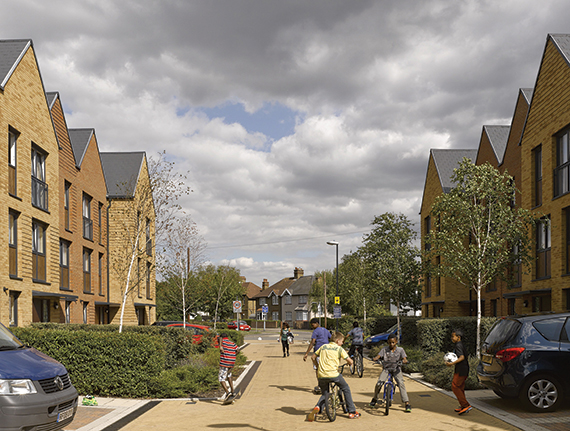
ANALYSIS: Will London mayor Sadiq Khan be able to boast on 1 April 2020 the fulfilment of a five-year-old promise by Transport for London to deliver 10,000 housing starts on 300 acres of TfL land?
A restive queue of 13 developers were selected as delivery partners in February 2016, after a year-long OJEU process. The first contract for 400 units was signed today.
None wish to protest openly, but complaints garnered are easy to summarise: spending the whole of 2015 putting together an over-long list of contenders was a mistake; spending the whole of 2016 producing tender documents for just three sites containing 550 units is glacially slow progress; TfL wants to over-control and micro-manage the programme, rather than simply sell the sites with simple conditions imposed.
“There is no way TfL can meet the timeframe,” says one complainant. “What has been going on is driving developers potty: sites have to be JVed with TfL; Khan’s pushing for 50% affordable; TfL insist on retaining the freehold. All points which add to the strain and cause delays. Putting out the contracts singly, instead of in batches is alienating bigger players. Small firms are excluded. We’ll be lucky to get 1,000 homes by 2020.”

The first contact, for 400 homes at Kidbrooke in south-east London, has been awarded to U+I and Notting Hill. The four-acre site was put out to tender seven months ago. In November last year, two more sites were put out to tender, Landmark Court in Southwark (100 units) and Fenwick Place in Clapham, SW9, where 55 units are planned. Then last week TfL said it seeking a partner for a site in Walthamstow, E17, although the 350 units are not slated to complete until 2022.
One more site will come to market soon. The plan is to bring sites with space for 3000 homes to tender by March 2018; again in the year to March 2019 and again in 2020, taking the total close to the 10,000 target by the mayoral elections in May 2020.
“The team now has real momentum in bringing sites to market,” says Francis Salway, the former chief executive of Land Securities who chairs TfL’s commercial development advisory group.
The pressure in now on TfL’s smallish development team, led by Graeme Craig, which has expanded from five to 23 staff, with seven more hires to come. “Graeme is a good man,” says a critic. “But he needs another 30 staff on top.” Can Craig promise to start work, rather than let contracts for 10,000 units by 2020? The man who joined TfL from Capita in 2004 as head of business operations wisely does not give a hostage-to-fortune answer:
“Our property strategy is to utilise our land to address the needs and challenges of London while generating vital commercial revenues to reinvest in the transport network,” he says. “We are working closely with the mayor’s office and boroughs to develop hundreds of acres of our land, building thousands of homes – half of which will be genuinely affordable.”
Last summer, developers began to quietly complain to the Greater London Authority housing committee. The committee conducted a two-month informal investigation in September and October. Representatives from TfL, property developers and housing associations were questioned.
On 1 November the committee, chaired by Conservative member Andrew Boff, quizzed TfL’s development director, Lester Hampson, about the lack of progress.
Hampson said: “While it has taken us 12 to 18 months to set the framework up, it now allows us to bring sites forward, over a three or four-month period.”
TfL has chosen the slow road, having little choice. Public money is at stake. The OJEU process is obligatory. Nobody wants a National Audit Office report revealing private sector profiteering. But why so many developers? Why not sell of batches of sites? TfL does not want to allow company to get a lock on too many sites, is one view. The memory of Land Securities halting work on 10,000 homes at Ebbsfleet after the 2007/9 crash is fresh.
One of the difficulties of the whole process is how to build out these sites if market conditions turn down, warns one former developer. It is a point politicians always ignore. Remember the Boris-propelled hype? Headlines in early 2015 shouting how TfL was to become “London’s biggest housebuilder” by 2025? TfL’s current budget calls for £850m to be raised from housing ventures by 2020.
Sites in the pipeline
This coming year TfL is to work up and tender 17 large sites. Each can deliver more than 100 homes: 11 more than 200, three of which can hold “significantly in excess” of 1,000 units. The mayor has demanded 50% of the overall number of homes are “affordable”. On some sites it will be 100%, on others as low as 20%. Two-thirds of the sites are in Zones 1 and 2. The others are in Zones 3 and 4. At Earls Court TfL already has a joint venture with Capital & Counties, for 1,800 units, which is not included in the plans. All sites are adjacent or over existing stations. TfL is now promising to bring extra smaller sites to market, after complaints from developers excluded from the current tender panel, which requires a bidder to hold at least £100m of net assets.
Let
- Kidbrooke: 400 units
Out to tender
- Landmark Court, Southwark: 100 units
- Fenwick Place, Clapham: 55 units
- Blackhorse Road, Walthamstow: 350 units
Withdrawn
- Northwood: 123 homes
- Parsons Green: 119 homes
Pipeline
- Nine Elms
- South Kensington
- Old Street roundabout
- Hammersmith bus station
- Vauxhall bus station
- London Underground HQ, 55 Broadway
- Hanworth Road, Hounslow
- Harrow on the Hill
- Bermonsey
The 13 developers
- Balfour Beatty
- Barratt Development and London and Quadrant Housing Association
- Berkeley Group
- British Land
- Canary Wharf Group
- Capital and Counties
- U+I and Notting Hill Housing Group
- Land Securities Group
- Mace / Peabody Trust / DV4 consortium
- Mount Anvil and Hyde Housing Association
- Redrow Homes
- Stanhope and Mitsui Fudosan
- Taylor Wimpey
Familiar faces
Former Land Securities chief executive Francis Salway chairs a four-strong group of senior property folk tasked with giving advice to TfL on its 10-year, 10,000-unit development programme. He says “momentum is building”. The commercial development advisory group was set up in 2015 under Boris Johnson. The other members are: Richard Cotton, former managing director of JP Morgan Cazenove; Mike Jones, former chairman at Drivers Jonas; Richard Jones: ex-managing director of UK real estate at Aviva Investors. Current Grainger boss, Helen Gordon stepped down from the group after being appointed chief executive of Grainger.










